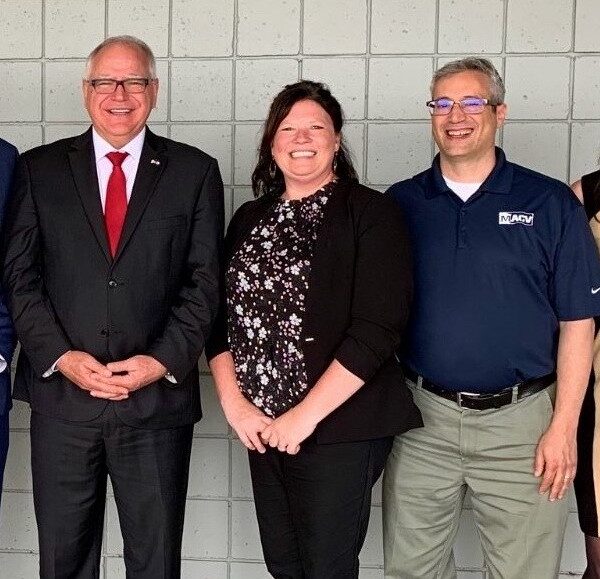According to Lindsey Hofer, her team working to end veteran homelessness is never content. Even when the Minneapolis/Hennepin County veteran team achieved a 14% reduction in veteran homelessness in 2022 — it still wasn’t enough.
“I would say this group — the whole veteran homeless response system — we’re never complacent,” explained Hofer, who is the Statewide Program Manager for the Minnesota Assistance Council for Veterans and Built for Zero lead. “We’re never happy with where we’re at. We’re continuously trying to get better. If this tiny thing isn’t working, let’s create a standard operating procedure around that so we can clear that up. Little things, big things — we’re consistently trying to improve.”
With an increase in resources and the strength of political support, along with the tenacity of their synergetic team, this Built for Zero community made a measurable reduction in their system during the first part of 2022, on the way to reaching functional zero for veteran homelessness.
Resources and relationships
A significant factor in achieving this reduction is the dynamic working relationship the Minneapolis/Hennepin County veteran team has developed with each other and with other partners, all the way up to the governor’s office on the state level.
“Our collaboration and our partnership is a really active relationship — and it has to be. It isn’t just natural that state, nonprofit, and federal agencies are working this closely together,” explained Larisa Breid, HUD-VASH Supervisor at the Minneapolis VA Health Care System. “We’ve invested an incredible amount of time and energy into these relationships, and that has taken place at every level.”
With these tight-knit relationships in place, the community was able to smartly utilize a recent influx of resources they received, strategizing together to render better results.
One of the largest sources of funding was from the Minnesota Department of Veterans Affairs, which awarded the Minnesota Assistance Council for Veterans (aka “MACV”) $6 million for 150 vouchers in 2021. The community also has SSVF Shallow Subsidies and HUD-VASH vouchers available, which offers more avenues to house veterans more quickly.
Derek Holt, Homeless Programs Coordinator at the Minnesota Department of Veterans Affairs, emphasized that many of their ideas for how to best use this funding have originated from their core collaborative group focused on veteran homelessness.
“We communicate quite a bit throughout the work day and work week about what is not working in our community and how we can leverage state resources to incorporate and assist with all the already-amazing federal resources that we have,” he said.
Using data to address housing and support service needs
Throughout 2022, the veteran team examined their quality by-name data — which they also call their “Homeless Veteran Registry” — to understand who was remaining without housing for longer periods of time.
“We’re very aware of, through the Homeless Veteran Registry meetings and case conferencing, what is the best path and the fastest path for each veteran.”
jonelle glubke
They found that, despite having housing vouchers, certain veterans were having a harder time meeting screening criteria used by rental property owners.
To help remedy this issue, $4 million was awarded to MACV from the Minnesota Legislature to create a new program called Veterans Supportive Housing Options. The goal of the program is to support individuals whose needs aren’t being met by the standard private rental market and its associated screening criteria. With that funding, MACV began purchasing rental property throughout the state of Minnesota, targeting properties that were off the market and/or vacant, to ensure they weren’t displacing anyone in the process. Coupled with this new housing stock, two new screening assessments were used to determine if a veteran could live independently by paying rent or through a subsidy.
As Holt explained, “We don’t want to put people into bad housing outcomes and then have them leave. And we know that makes it harder to end their next episode of homelessness.”
In this same vein, the team’s quality data highlighted that veterans were having a harder time exiting homelessness upon repeated instances of homelessness. In response, funding was used to launch long-term case management for veterans who have struggled to maintain housing in the past and didn’t already have case managers. This ongoing connection is designed to reduce recidivism into homelessness.
“It’s so important that, with all of these new resources coming on, that we actually now have, we feel, a really solid homeless response system in our community that meets the needs of every veteran,” said Jonelle Glubke, Director of Homeless Programs at the Minneapolis VA Health Care System. “We’re very aware of, through the Homeless Veteran Registry meetings and case conferencing, what is the best path and the fastest path for each veteran.”
Engaging landlords to increase veteran placements
Engaging local property owners has been another community-wide strategy that the team credits as contributing to their reduction, since it has allowed them to connect veterans to housing more rapidly.
“We are developing a pool of landlords that are willing to relax their tenant screening criteria to work with our programs, and who know that we will be responsive to tenancy concerns and that we will be filling units,” Breid said.
MACV’s landlord engagement team actively recruits property owners, while the different housing programs respond quickly with potential tenants when units become available. Additionally, the Minnesota Department of Veterans Affairs provides landlord mitigation and landlord incentive funds, which help reduce a landlord’s risk in renting to veterans. These funds give a cash incentive to property owners when they house veterans with the highest barriers to housing, while also covering damages or unpaid rent after a tenant leaves.
Breid calls this “a game-changer for us in expanding our pool of units for veterans who have negative housing histories or legal histories.”
“Through the last two years of that program, we see and have placed about 150 veterans with a 90% retention rate.”
derek holt
Moreover, MACV’s Landlord Engagement Team participates in a program called Homes for Veterans, which encourages landlords to widen their screening criteria for potential tenants. Across Minnesota, the average turnover rate for rental units is 50% — meaning that after the first year, half of tenants will move out, either on their own accord or by way of the landlord’s decision. Having a high turnover rate and regular vacancies is more expensive for a landlord than having a tenant remain in the unit. But the Homes for Veterans program has rendered significantly above average results.
“Through the last two years of that program, we see and have placed about 150 veterans with a 90% retention rate,” Holt said. “We are showing the landlord that previous history does not impact or is not a predictor of future success.” This success, he continued, has also shown landlords ways they can better manage their business model and make it more profitable, which in turn encourages them to be more willing to rent to veterans who have experienced homelessness.
Improving the equity of their system
Throughout all of their work, the Minneapolis/Hennepin County veteran team prioritizes equity of their system to figure out ways to improve it. One of the ways they’ve addressed this is through a Racial Equity Workgroup, facilitated by Racial Equity Partners, that discusses ways to use that data to begin improving equity outcomes. This workgroup incorporates and centralizes the voices of veterans with lived experience of homelessness.
“The reason we know there’s inequity in VA eligibility, or in our outcomes by race and gender, or even in the high barrier score, is that all of that is tracked and updated on a weekly basis in our Homeless Veteran Registry,” Hofer said. “We wouldn’t know those inequities or have started a lot of these programs without that.”
In 2019, the team ran data reports and discovered that veterans experiencing homelessness were not being housed at the same rate across all racial groups. Veterans of color were remaining on the Homeless Veteran Registry longer and were not accessing housing opportunities at the same rate as their white peers. Similarly, veterans with certain types of discharge statuses were struggling to find and access resources to exit homelessness because certain discharge statuses didn’t meet the federal VA definition for veterans.
“We saw this as an equity issue, as well,” Holt said. “As we know, often discharge statuses are impacted by race and color. And we wanted to try to make sure that people had equal access to housing.”
In response, the team expanded their definition of veterans by using the term “former service member,” which is defined as anyone who has served for one day with a discharge status that is not considered eligible by the VA. This change expanded eligibility for state resources and was reflected in language added throughout their contracts and grants.
“You’re not pointing fingers when you have an accurate story and accurate data. You’re presenting the facts, and you’re leveraging the idea that Minnesota is a state oriented to helping people. And we want to make sure that everybody has equal access,” Holt said.
Addressing challenges together
Looking forward, the veteran team at Minneapolis/Hennepin County continues to find ways to improve their system by ensuring it operates sustainably. They plan to strategize and develop solutions to move upstream and prevent homelessness by keeping people in their units so they don’t return to homelessness.
“That really excites us to know that we have this system and that we’re really able to meet veterans’ needs as best as we possibly can,” Glubke said.
Glubke knows that being a part of a “very dynamic, positive, and collaborative” team has been crucial to their community’s current reduction and ultimate goal to functionally end veteran homelessness.
“For us, it really has been years in the making,” she explained. “[It comes down to] our commitment, our willingness, and all of our flexibility to be able to drop whatever needs to be dropped, so that we can make sure that we’re looking at the system, we’re identifying any barriers, and we’re addressing them together.”



